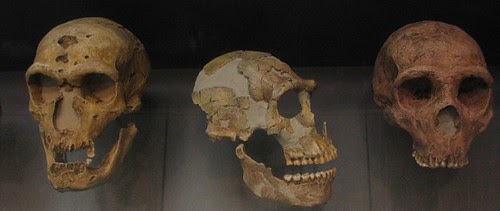Teeth discovered in Jersey indicate Neanderthals interbred with Homo Sapiens

Three Neanderthal skulls are pictured, which depict the bony ridge above the eyes and the elongated skull shape, among other characteristics.
Neanderthal teeth originally found in 1910 and 1911 in La Cotte de St Brelade have recently been studied again and found to show a connection between Neanderthals and Homo Sapiens. Initially, researchers believed that the 13 teeth belonged solely to the Neanderthals, but traits from modern human teeth were seen in this new study.
Neanderthals were originally believed to have gone extinct about 40,000 years ago due to climate change and disease, but they may have never gone entirely extinct. Instead, it is possible that they interbred with Homo Sapiens and the Neanderthal species was absorbed into that of the Homo Sapiens.
These two species are known to have overlapped for over 5,000 years in Europe, which means that the Homo Sapiens species having absorbed the Neanderthal species is not impossible. It even seems likely to be the cause for the disappearance of Neanderthals, as we can see several attributes in modern humans from Neanderthals. These traits from Neanderthals originate from over 40,000 years ago when Neanderthals and Homo Sapiens first met.
“It would be interesting to see if those qualities from so long ago somehow affected modern humans’ lives today,” said Early College student Angelina Guerrero.
These recognizable traits include a bony ridge above the eyes, broad fingers and freckles. The most apparent of these traits is the bony ridge above the eyes, which should be recognizable almost immediately.
Despite all of these characteristics of Neanderthals, the DNA of modern humans contains very little DNA from Neanderthals. according to research conducted by anthropologist Max Planck. People of African origin tend to have 0 percent Neanderthal DNA, while people of European and Asian origin tend to have 1 to 3 percent Neanderthal DNA.
Despite evidence that Homo Sapiens and Neanderthals interacted 40,000 years ago, the reason for Neanderthals’ disappearance is unknown. Some believe that the Homo Sapiens carried pathogens from Africa that wiped out Neanderthals. While we still do not have a definitive answer as to what may have happened to Neanderthals, there is now evidence indicating that previous beliefs regarding Neanderthal extinction may be incorrect.
Overall, the teeth discovered in 1910 and 1911 in La Cotte de St Brelade revealed several exciting pieces of evidence that fit into the puzzle as to what happened to the Neanderthal species. T One theory about the disappearance of the Neanderthals involves Homo Sapiens, but it does not involve Neanderthals interbreeding with Homo Sapiens. Some believe that the large influx of Homo Sapiens from Africa into Europe separated groups of Neanderthals, and that due to the already small size of the Neanderthal population, the Neanderthal groups slowly died out due to being isolated. Whether Neanderthals were aided or harmed by Homo Sapiens will remain a mystery for many years to come.










